HFC Braille Publication Guide
September 2023
The following guidance helps parks produce, procure, and share braille editions of all park publications. Use the guide to produce a quality, standardized product based on the latest braille and NPS identity standards, laws, and policies. For additional information, please refer to the Braille Authority of North America, US laws covering disability rights, NPS Director's Order #42, and NPS Graphic Identity or contact HFC's Accessibility Coordinator Michele Hartley.
*Note - Printing this page will open all tabs.
About Braille and Transcription
HFC follows the standards of the Braille Authority of North America (BANA). Among the publications they offer is The Rules of Unified English Braille, American Edition, which includes this information:
“Braille is a tactile method of reading and writing for blind people developed by Louis Braille (1809– 1852), a blind Frenchman. The braille system uses six raised dots in a systematic arrangement with two columns of three dots, known as a braille cell. By convention, the dots in the left column are numbered 1, 2, and 3 from top to bottom and the dots in the right column are numbered 4, 5, and 6 from top to bottom. . . . The six dots of the braille cell are configured in 64 possible combinations (including the space, which has no dots present). The 63 braille characters with dots are grouped in a table of seven lines. This table is used to establish ‘braille order’ for listing braille signs.”
Terminology
Prepare for a transcription
The objective of a braille transcription is to present the same information to a braille reader that other visitors get from the printed Unigrid brochure; however, before sending the project to the braille contractor, you must edit visual references and adjust order and flow to improve the braille reading experience.
Prepare the text file for the transcriber.
Find and edit visual references in the text and captions. Add identifying information for photographs and illustrations. It may be helpful to read the brochure’s text file without looking at the printed brochure. Braille readers need to know what kind of image you are referencing. Refer to a photograph as “picture” or “pictured,” refer to a drawing or painting as “illustration” or “illustrated,” refer to a map as “map.”
When do visual references need editing?
- Text connects information to an illustration or map. Edit for braille by providing the location information. Example: Monument moved to the traffic circle as you approach the visitor center not Monument moved to where it is now.
- Text refers to an image. Edit for braille by replacing directions to photographs with picture, pictured, illustration, or illustrated carefully located in the sentence next to the subject of the image. Example: In this part of the park are brown/grizzly bears (pictured), moose, caribou (pictured), sea lions, seals, . . . not In this part of the park are brown/grizzly bears (shown above), moose, caribou (photo at right), sea lions, seals, . . .
- Caption assumes the reader can see the image. Edit for braille by identifying the type of image and describing the detail. Example: Picture: Patriotic envelopes with printed flags and cannon were issued after the battles not Patriotic envelopes like these were issued after the battles.
When do visual references require additional text?
- Images are not captioned. Add identifying text.
- Images always need to be identified in braille with “Picture(d)” or “Illustration/Illustrated.” Always identify the type of image at the start of the caption with “Picture” or “Illustration,” etc. Examples: Picture: Delaware River and Arrow Island and Illustration: Interior of a hogan.
- Text relies on an image. Add language for the reader’s understanding. Example: Picture: People running Aniakchak River rapids in a rubber raft not Picture: Running Aniakchak River rapids.
- Map or diagram contains information important to the story that is not in the main text. Edit for braille by identifying the map or diagram and then adding a caption or note. When available, insert text from map. (See Maps and Diagrams.) Example: Diagram: April 7, 1862 Union movements and Confederate retreat.
- Sidebar or other secondary material is identified by a visual treatment (an inset, color background, outline, or different font). Edit by identifying the secondary material. Example: Sidebar: [Follow with the title and text copy] or Box inside map: [Follow with the title and text copy].
- Chronology. Add at the beginning “A chronology follows.”
- Numbered tour guide. Add at the beginning “Numbered tour stops follow.”
- List. Add the text “List Follows.” At the end of the list, add “End of List.”
Chronology and content are more important than visual hierarchy in terms of order and flow. For example, a caption may be inserted into the flow of the narrative text, which may require some editing to eliminate redundancy.
Visitor information about safety, regulations, and programs is generally at the end of the printed brochure. To make it easier for a visitor to go directly to this information, insert a sentence at the start of the transcription giving the booklet’s page number where this information will be, and instruct the transcription house about identifying this section. Example: To plan your visit to [the park], begin on page 00. (See Sample Transcription-Ready Manuscript.)
In the “Plan Your Visit” section, the flow of information may need to be made more logical for a braille reader. The accessibility statement should be in a logical place for the braille reader regardless of how it is placed in the original text; in many cases, it is moved up in the hierarchy.
This is the recommended flow:
- Visitor Center(s) - general planning
- Accessibility
- Activities [introduction]
- Safety
- Activities [specific]
- Services/Accommodations
- Directions
- More Information
Position emergency information to emphasize importance. The NPS style is to set this information flush left.
You do not need to include credits for images because the images are not being reproduced; however, if an artist is identified in the caption, keep that in the transcription.
The braille reader cannot see font styles such as italics, bold face, and all caps that often indicate emphasis or hierarchy in the text. In braille, emphasis does not serve the purpose of drawing the reader's attention. For the most part it represents clutter, so simplify by using emphasis sparingly. Transcribers will use lines spaces and indents to create order and hierarchy. Limit headers to four levels. (See Sample Transcription-Ready Manuscript.)
For paragraphs starting with bold introductory text followed by an en space, add a colon. These will then show up in the braille transcription with the first line indented then continuing flush left. Example: By Road: The main park entrance . . . not By Road The main park entrance . . .
- Italics except for ship names, publication titles, and direct quotations.
- Bold. Braille transcription has no symbol to indicate bold, so the transcription house will indicate italics instead. This adds information the reader does not need. Change to roman.
- Double styles like bold italic.
- All caps.
Titles of lists should be flush left. Indent list contents to the third cell position, to alert braille readers that the text is part of a list. If a list spans several transcription pages, you do not need to add “continued” at the end of each page or repeat the list title at the start of each page; the indention is enough for the braille reader to follow.
Keep bullets for bulleted lists (like those that often appear in the safety or regulations section). Begin all bullets on the left margin. Add a bullet to the first item, if it does not already have one. The transcriber will add a character that represents a bullet and indent lines after the first line of each entry.
Combine timelines that are presented separately (for example, national events in one timeline and local events in another). In this example, one of the two categories (national or local) are indented, and a note is added at the beginning alerting the braille reader what the indent means. In some cases, a two-column timeline may be necessary but is a second choice. A note to the transcriber may also be helpful to alert them to the style preference and intention.
Instead of creating a chart or table in braille, edit to a list, paragraph, or columns. To create a tactile chart or table discuss in advance with the transcription house because it is considered a complex transcription and is not included in the standard scope of work.
Keep in mind:
- Not all transcription houses can recreate a chart or table.
- A chart or table is recreated using raised lines with sufficient spacing to place the braille cells in the correct spaces. Each chart or table requires at least one page, which increases booklet size and may give the information more importance than necessary—or may require spreading the information across pages, which increases reading difficulty.
- If a chart or table includes symbols or pictographs, provide a symbol key on the preceding page.
Before creating a map or diagram as a tactile graphic, discuss it in advance with the transcription house. Tactile graphics are considered a complex transcription and may not be available from all transcription houses. HFC’s braille booklets are simple transcriptions and do not contain tactile graphics, maps, or diagrams.
Design the publication
Create your own, per the following specifications, or use HFC’s template. HFC’s format for the cover has the park name in braille and other information printed in ink so anyone can identify the publication. (See Sample Cover Page.) The following information corresponds to the sample and template:
- The format is 8.5” x 11” with black comb binding, which allows the booklet to lay flat.
- The cover layout uses NPS Graphic Identity standards, including font sizes and styles.
- Most information is ink-printed in black.
Top heading
- Between the black bars show the park name, location, NPS and USDOI spelled out, and the NPS Arrowhead.
- Below the second bar indicate the original publication being transcribed. Example: “A 2020 braille transcription of the Unigrid brochure CODE 2020 [imprint number] edition.”
- Center: Park name is repeated in embossed braille.
- Bottom material: Between the black bars show the publisher (your park name and address), and the type of braille publication. Example: “This edition is a Unified English Braille transcription.
Use the Braille Cover Page template
A cover template is available. You will need Adobe InDesign, Acrobat Pro, and the NPS official fonts, which are available only to employees of the National Park Service.
Regardless of how the titles are presented in the black band of the original Unigrid brochure (Aformat is generally different from B-format), use the following style for the second page of the braille edition:
Full Park Name (set on one line if possible, no line break)
State Name
National Park Service
U.S. Department of the Interior
Published by National Park Service
Harpers Ferry Center, Publications Office
PO Box 50, Harpers Ferry, WV 25425
Visitor Information Brochure
CODE year-[GPO imprint number]
This edition is a Unified English Braille transcription.
For information not readily apparent by reading the text alone, transcribers will add notes at the beginning of a document. Transcriber note pages are numbered with a letter T. The beginning of the document may start with T1, before page 1.
Contract for a braille transcription
Parks are not required to go through the Government Printing Office (GPO) for braille services. Your contracting officer should be able to arrange this or may recommend you work with GPO on a spot bid for transcription and duplication services. The information in this section applies whether you go through GPO or not.
Scope of Work
- Create a Unified English Braille transcription from the government-supplied digital file and/or manuscript defined as straightforward textural matter.
- Create an ink-print cover from supplied PDF, adding the braille embossed park title.
- Proofread the transcription.
- Deliver one “prior-to-production” interline PDF for review and approval before embossing the production copies.
- Bind with black comb or wire binding on left vertical edge.
- Deliver one advance production braille booklet for approval.
- Ship the bulk order to the park. The contractor can use the US Postal Service’s “free matter for the blind” service if no package tracking is required.
- Upon completion, return government-furnished materials and the final BRF file (needed for reprints and for posting on your park website) that is suitable for embossing additional copies and one final interline PDF (needed to make changes for reprints). The digital deliverables must be an exact representation of the final embossed product.
- Quantity
- HFC recommends a minimum of 32 copies (30 copies for public use, plus two copies for your files).
- Trim size
- 8.5” x 11˝
- Number of pages
- 1 ink-printed cover with embossed title
- 1 blank back cover
- 1 transcribed title page leaf
- 1 or more transcriber note pages
- An estimated number of interpoint embossed pages
- Single page or interpoint embossing
- Government-furnished materials
- Digital manuscript
- PDF for the cover
- One copy of printed brochure for reference only.
- It is also helpful to send a printout of the digital manuscript and the inkprinted cover file.
- Paper stock
- Most transcription houses have a house stock that meets these requirements: 90 or 100 lb. white book or index, 25.5 x 30.5˝, equal to JCP K10.
- Avoid recycled content. Recycled stock has strength issues and impurities that may cause the cell structure to be weak or incomplete when embossed.
Estimate the number of pages of the finished product. If you are starting with a singlespaced manuscript, multiply the number of manuscript pages x 3.5. Add front cover, back cover, transcriber note page, and title page. Example: 8-page manuscript x 3.5 = 28 + two covers + 1 title page = 31 pages. Add a couple more pages if the manuscript has lists or chronologies.
Costs include transcription, “prior-to-production” interline PDF, embossing, printing, binding, packaging, and shipping. If you go through GPO, add the 8% surcharge and $7.50 processing fee. Booklets mailed using the USPS “free matter for the blind” service are shipped at no cost. If tracking is required, the contractor will have to ship using another method. Any other shipping costs (e.g. delivering proofs, returning materials) should be paid by the transcription house.
Review and Approve
Once you have sent your files to the transcription house, you can expect the following:
- One “prior-to-production” interline PDF to review and approve for production.
- An “advance” copy to review and approve prior to shipment.
- Braille booklets.
- Government- furnished materials and the final BRF file and interline PDF.
The transcription house is responsible for proofreading the entire document, but you need to ensure key elements are transcribed properly. (See list below.) You can ask someone who is experienced in braille to provide this service, or you can check the items yourself. It is relatively easy if you know what to look for and use the charts in the BANA guide.
- Title is usually centered.
- For the visitor information section, find the page number provided on page one then find the page where the information should be. (They should match up.)
- Headers are usually separated from body text by line space above and below and are usually centered.
- For lists, the header should be flush left and items indented to third cell.
- Page numbers should appear on the right-hand pages only, in the upper right. Look for the cell that means “page number” then check the number.
- GPO surcharges: If ordered through a spot bid, GPO adds 8% and a $7.50 processing fee to the contractor’s cost (these figures may change). That is the amount that you should approve for payment.
- GPO extra copies: Review your invoice carefully to ensure GPO does not charge you for the extra copies it provides to the Library of Congress and depository libraries. If you notice these costs on your bill, contact GPO.
- Transcription house: If you order directly from them, they will bill for their services and the deliverables.
Post the Transcription to the Web
Post the BRF file on your park website. People with braille embossers can download the file and print their own embossed braille booklet or use it on a refreshable braille display.
Transcribing and Embossing Services
There are several braille transcription houses in the United States.
American Printing House for the Blind
Louisville, Kentucky
502-895-2405
www.aph.org
Clovernook Center for the Blind and Visually Impaired
Cincinnati, OH
513-522-3860
https://clovernook.org/braille-printing-house/
LightHouse for the Blind and Visually Impaired
San Francisco, CA
415-431-1481
https://lighthouse-sf.org
National Braille Press
Boston, MA
888-965-8965
www.nbp.org
SeeWriteHear
Scottsdale, AZ
480-696-1869
www.seewritehear.com
Sample Scope of Work
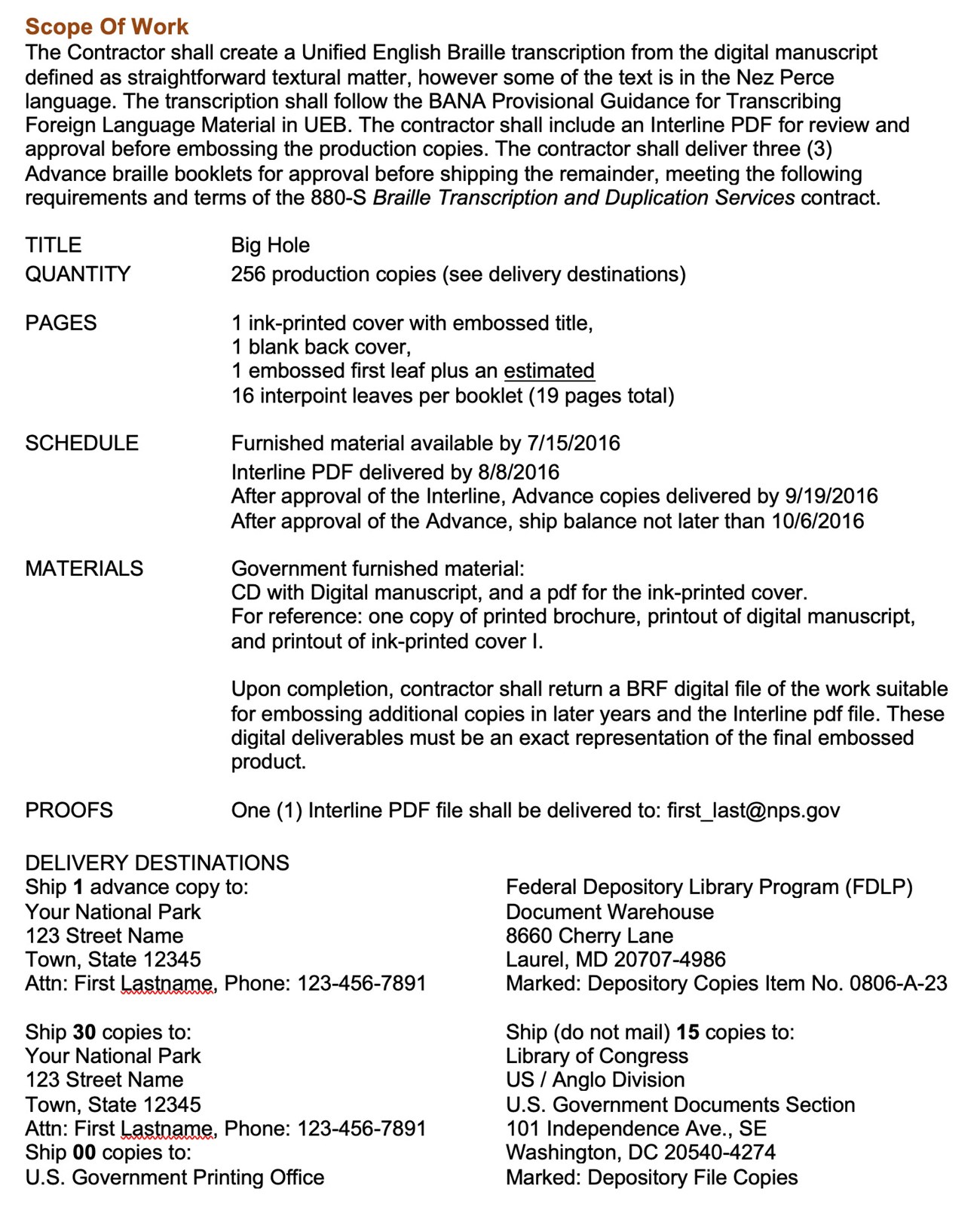
Sample Braille Booklet Cover
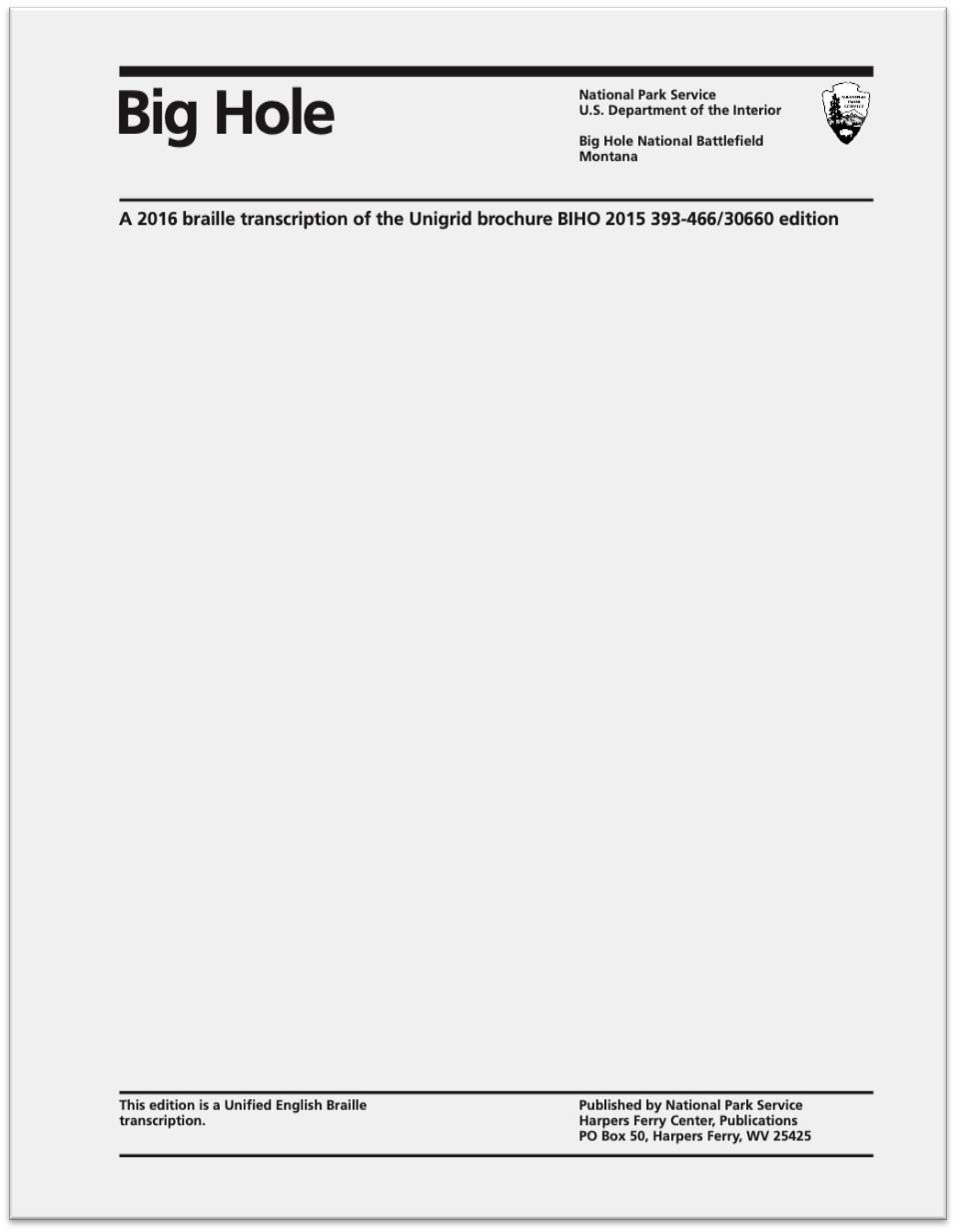
Sample Transcription-Ready Manuscript

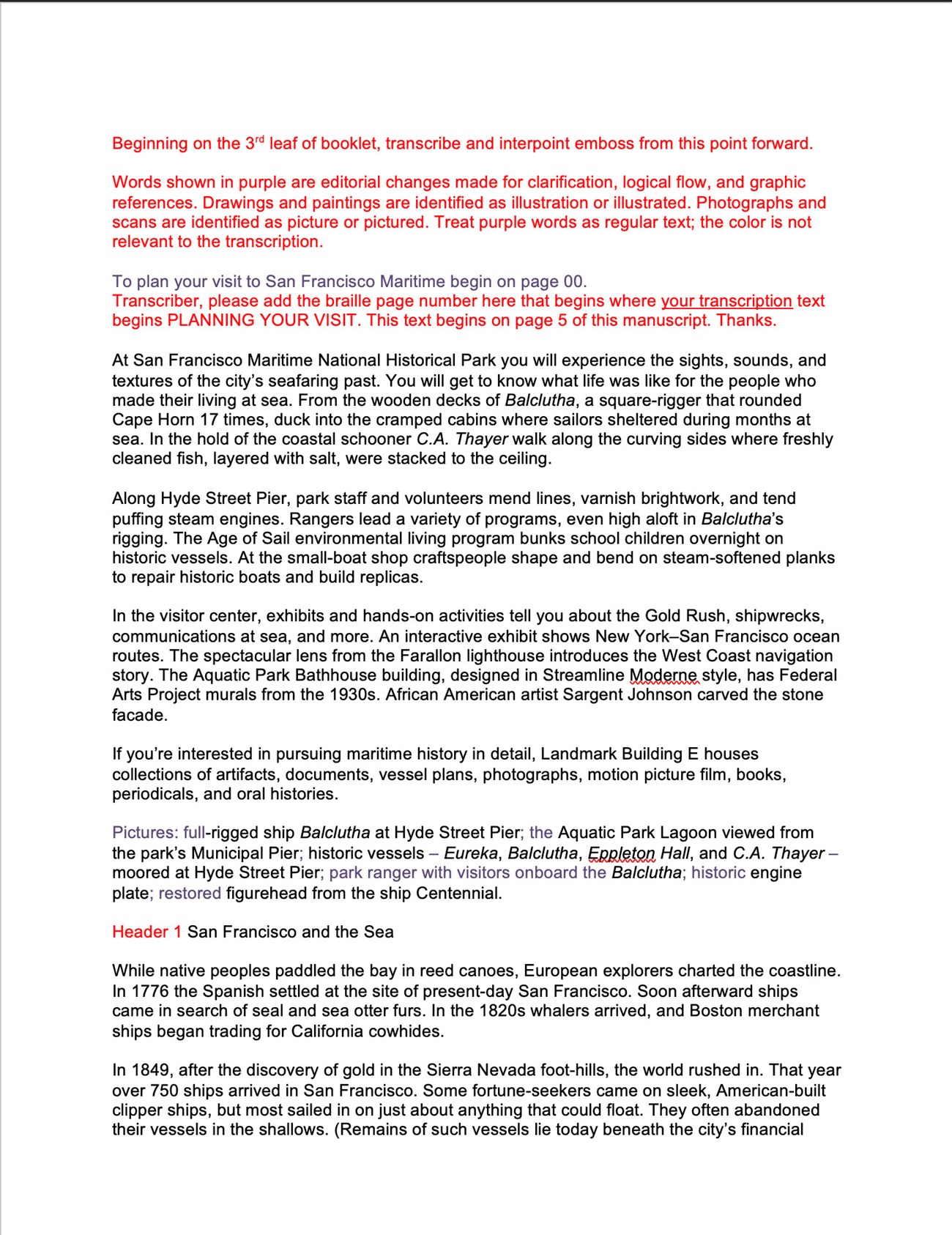

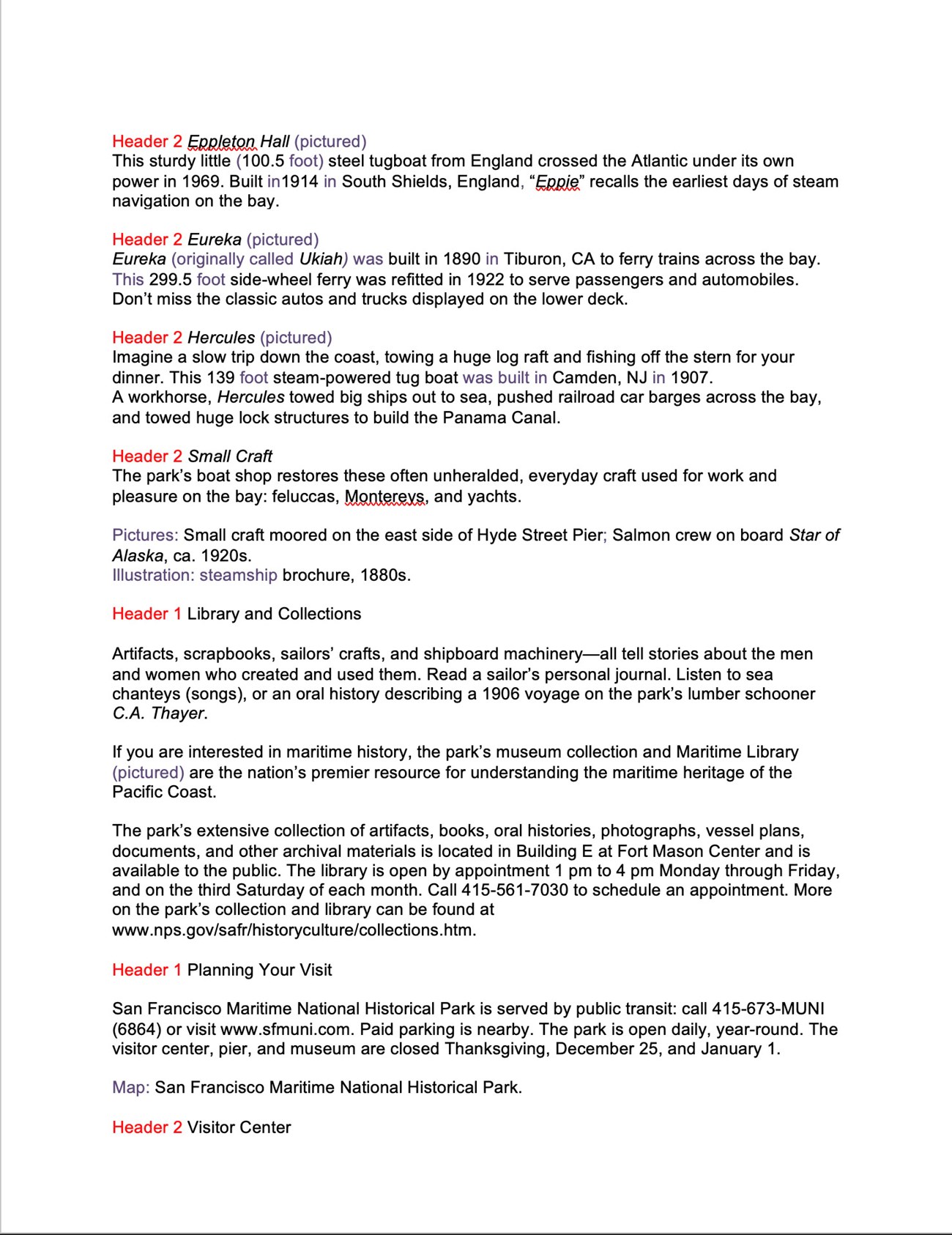
Sample Interline Page
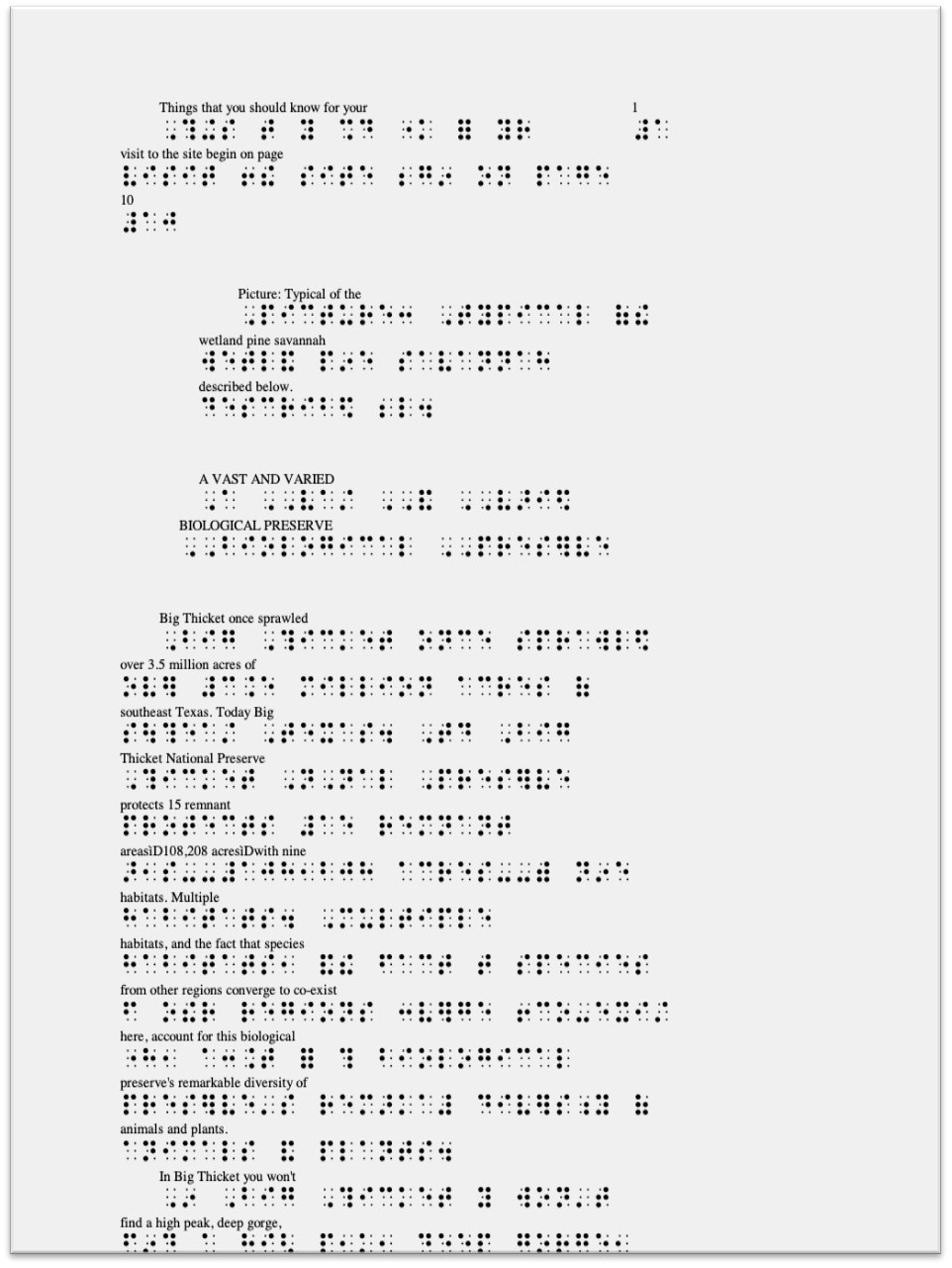
Last updated: May 29, 2025
